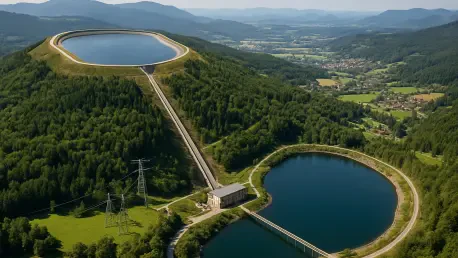As Europe races toward a cleaner, more sustainable energy landscape, a pressing question emerges: how can the continent balance the intermittent nature of renewable sources like wind and solar while ensuring a stable power supply? Enter pumped storage hydropower (PSH), a time-tested technology that could hold the key to bridging this gap. With the recent launch of a groundbreaking initiative by leading energy organizations, there’s a renewed focus on scaling up PSH to meet ambitious climate goals. This strategic push not only highlights the technology’s potential to store vast amounts of electricity for long durations but also underscores its role in creating a resilient grid. By delving into this collaborative effort, the critical need for energy storage, and the policy reforms required to accelerate deployment, a clearer picture emerges of how PSH might shape the region’s transition to a renewable-dominated system.
Unlocking Potential with a Unified Initiative
A significant stride in advancing PSH across Europe has been made through a bold commitment by over 50 utilities, suppliers, and energy associations. This coalition, driven by a shared vision, aims to fast-track the development of PSH projects to support the integration of renewable energy. The initiative emphasizes actionable steps such as substantial investments in new facilities, bolstering the regional supply chain, and adopting innovative technologies to enhance efficiency. Beyond technical advancements, there’s a strong focus on mitigating environmental impacts and fostering transparent communication with local communities. Engaging policymakers from the outset ensures that projects align with broader sustainability objectives while also addressing social concerns. This unified approach signals an industry-wide recognition of PSH as a cornerstone for achieving energy security, providing a scalable solution that currently dominates global electricity storage with over 90% of capacity.
The momentum behind this collaborative effort also shines a light on the sheer scale of ongoing and planned PSH developments. Across Europe, more than 32 gigawatts of new capacity are under construction or in the pipeline, with an additional 3 gigawatts in neighboring areas, collectively offering over 700 gigawatt-hours of storage. These figures underscore the technology’s readiness to meet rising demand as renewable energy sources expand. Furthermore, the initiative prioritizes training a diverse workforce to sustain long-term growth, ensuring that the sector is equipped to handle both current and future challenges. By weaving together economic, technical, and social priorities, this pledge creates a robust framework for PSH to thrive. The emphasis on community involvement and environmental stewardship sets a precedent for how large-scale energy projects can balance progress with responsibility, paving the way for broader acceptance and support.
Addressing the Storage Challenge in Renewable Growth
The rapid expansion of wind and solar power in Europe has brought an urgent need for reliable energy storage solutions to manage fluctuations in generation. PSH stands out as a proven method, capable of storing excess electricity during periods of high production and releasing it when demand peaks. This long-duration storage capability is vital for maintaining grid stability, especially as the share of renewables continues to grow. Unlike other technologies that may struggle with scalability or cost, PSH offers a cost-effective and efficient option, making it an indispensable asset for a renewable-powered future. Industry leaders have highlighted its role in not only balancing supply and demand but also supporting the overarching goals of reducing carbon emissions. The technology’s ability to act as a giant battery for the grid positions it as a linchpin in the transition to cleaner energy systems.
Beyond its technical merits, PSH also contributes to economic and environmental objectives by fostering job creation and supporting climate targets. However, realizing its full potential requires overcoming hurdles such as environmental concerns and the need for skilled labor. Collaborative efforts are underway to address these issues, with a focus on sustainable project design and comprehensive training programs. The technology’s track record—accounting for the majority of global storage volume—demonstrates its reliability, yet the pace of deployment must accelerate to keep up with renewable growth. As Europe pushes toward a decarbonized energy sector, PSH provides a practical solution to ensure affordability and resilience. This dual benefit of stabilizing the grid while aligning with green ambitions makes it a critical component of the energy mix, demanding attention from both industry stakeholders and regulatory bodies to unlock its full capacity.
Navigating Policy Barriers for Wider Adoption
For PSH to reach its transformative potential, supportive regulatory frameworks at both national and European Union levels are essential. Industry voices have called for dedicated policies that recognize the unique value of long-duration storage, including separate legislative measures and fair compensation for system services. Eliminating double grid fees and streamlining permitting processes are also critical to reducing financial and administrative burdens on developers. Such reforms would create an environment where PSH projects can flourish, enabling faster integration into the energy system. The consensus among stakeholders is clear: without decisive policy action, the ambitious targets for renewable energy adoption risk falling short. Regulatory clarity and incentives are seen as the catalysts needed to attract investment and drive innovation in this space.
Additionally, the push for policy reform is accompanied by a broader dialogue on aligning PSH development with societal and environmental priorities. Transparent engagement with local communities and early consultation with policymakers can help address potential opposition and build trust. There’s also a growing recognition of the need to harmonize regulations across borders to facilitate cross-regional projects, which could maximize storage capacity and grid reliability. The urgency of these changes is amplified by the looming deadlines of climate commitments, pressing governments to act swiftly. By creating favorable conditions, regulators can ensure that PSH not only supports renewable integration but also contributes to a stable and affordable energy future. This intersection of policy, technology, and public interest highlights the complexity of scaling up PSH, yet also points to a clear path forward through coordinated action and strategic reforms.
Building a Sustainable Energy Legacy
Reflecting on the strides taken, the collective commitment to pumped storage hydropower marks a turning point in Europe’s journey toward a renewable energy landscape. The unified vision of industry leaders and associations demonstrates a resolve to tackle the storage challenge head-on, while substantial projects in development showcase the scalability of this technology. Regulatory advocacy has been pivotal, with persistent calls for streamlined policies and fair incentives shaping the conversation around long-duration storage. Looking ahead, the focus must shift to implementing these frameworks effectively, ensuring that environmental and workforce challenges are met with innovative solutions. Strengthening cross-border collaboration and maintaining transparent dialogue with communities will be crucial next steps. By sustaining this momentum, Europe can solidify PSH as a backbone of its energy transition, paving the way for a grid that is not only cleaner but also more reliable and resilient for generations to come.









